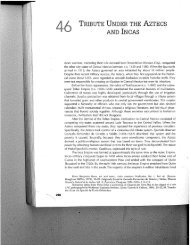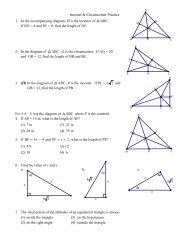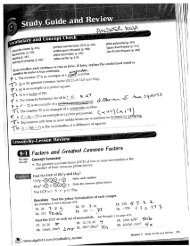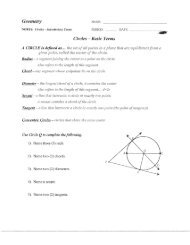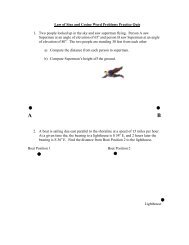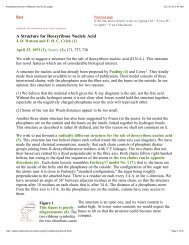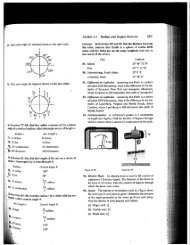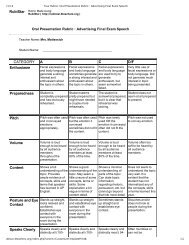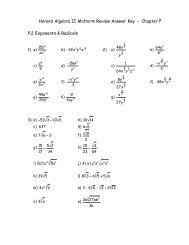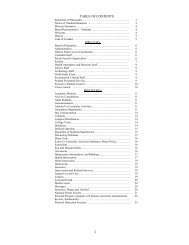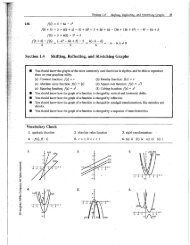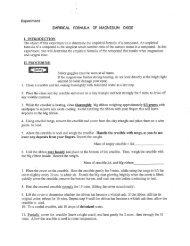JEAN-FRANCOIS STEINER From Treblinka
JEAN-FRANCOIS STEINER From Treblinka
JEAN-FRANCOIS STEINER From Treblinka
You also want an ePaper? Increase the reach of your titles
YUMPU automatically turns print PDFs into web optimized ePapers that Google loves.
World War H and GenocideWe have taken none of it for ourselves. Individuals who transgress wilbe punished in accordance with an order I issued at the beginning,threatening that whoever takes so much as a mark of it for himself isdead man. A number of SS men -- not very many -- have transgressed,and they will die, without mercy. We had the moral right, we had theduty toward our peop!~, to kill tl~is people which wanted to kii! us. Butwe do not have the right to enrich ourselves with so much as a fur, awatch, a mark, or a cigarette, or anything else. Having exterminated agerm, we do not want, in the end, to be infected by the germ, and die ofit. I will not stand by and let even a small rotten spot develop or takehold. Wherever i~ ~y form, we together will cauterize it. All in allhowever, we can say that we have carried out this heaviest of our tasksin a spirit of love for our people. And our inward being, our soul, ourcharacter has not suffered injury from it.<strong>JEAN</strong>-<strong>FRANCOIS</strong> <strong>STEINER</strong><strong>From</strong> <strong>Treblinka</strong><strong>Treblinka</strong>, in Poland, was one of several Nazi death camps.(Auschwitz was the largest camp.) (See Map 25.1.) tn these "deathfactories," the Nazis murdered millions of Jews as well as many thousandsof Roma and Sinti, socialists, Soviet prisoners of war, and otherpeople. In this selection, Steiner, who lost his father at <strong>Treblinka</strong>, revealshow "rational" and "scientific" mass murder can be. How couldthis happen? Can it happen again?Thinking HistoricallyTry to imagine what went through the mind of Lalka as he desiguedthe extermination process at <strong>Treblinka</strong>. How did concerns for efficiencyand humartity enter into his deliberations? Do you think hefound his work distasteful? ff so, which of the strategies mentioned inthe previous selection did he adopt?Jean-Francois Stekaer, <strong>Treblinka</strong> (New York: Simon & Schuster, 1967), 153-54,159-;60,
ir II and Genocidetrselves. Individuals who transgress will:h an order I issued at the beginning,so much as a mark of it for himself is a-- not very many -- have transgressed,:y. We had the moral right, we had thethis people which wanted to kill us. But:ich ourselves with so much as a fur, a,r anything else. Having exterminated ad, to be infected by the germ, and die of~en a small rotten spot develop or takeve together wilt cauterize it. All in all,.ve carried out this heaviest of our taskse. And our inward being, our sou!, our~ from it.N~OIS <strong>STEINER</strong><strong>Treblinka</strong>one of several Nazi death camps.imp.) (See Map 25.1.) In these "deathI millions of Jews as well as many thoudists,Soviet prisoners of war, and otherer, who lost his father at <strong>Treblinka</strong>, remtific"mass murder can be. How couldain?ing Historically’ough the mind of Lalka as he designed<strong>Treblinka</strong>. How did concerns for effiltohis deliberations? Do you think heso, which of the strategies mentioned indopt?York: Simon & Schuster, !967), 153-54,933
World War II and GenocideWhat would it have been like to be a sign-painter, guard, or haircutterat <strong>Treblinka</strong>?Each poorly organized debarkation [of deportees from trains arrivingat <strong>Treblinka</strong>] gave rise’to unpleasant scenes- uncertainties and confu~sion for the deportees, who did not know where they were going andwere sometimes seized with panic.So, the first problem was to restore a minimum of hope. Lalka 1 hadmany faults~ but h~ ~tid not lack a certain creative imagination. After a fewdays of reflection he hit upon the idea of transforming the platform wherthe convoys [trains] arrived into a false station. He had the ground filledin to the level of the doors of the cars in order to give the appearance of atrain platform and to make it easier to get off the trains .... On [a] wailLalka had.., doors and windows painted in gay and pleasing colors. Thewindows were decorated with cheerful curtains and framed by greenblinds which were just as false as the rest. Each door was given a specialname, stencilled at eye level: "Stationmaster," "Toilet," "Infirmary"red cross was painted on this door). Lalka carried his concern for detail sofar as to have his men paint two doors leading to the waiting rooms, firsand second class. The ticket window, which was barred with a horizontalsign reading, "Closed," was a little masterpiece with its ledge and falseperspective and its grill, painted line for line. Next to the ticket window alarge timetable announced the departure times of trains for Warsaw, Bialystok,Wolkowysk, etc .... Two doors were cut into the [wall]. The firstled to the "hospital," bearing a wooden arrow on which "Wolkowysk"was painted. The second led to the place where the Jews were undressed;that arrow said "Bialystok." Lalka also had some flower beds designed,which gave the whole area a neat and cheery look ....Lalka also decided that better organization could save much timein the operations of undressing and recovery of the [deportees’] baggage.To do this you had only to rationalize the different operations,that is, to organize the undressing like an assembly line. But therhythm of this assembly line was at the mercy of the sick, the old, andthe wounded, who, since they were unable to keep the pace threat.ened to bog down the operation and make it proceed even more slowlythan before .... Individuals of both sexes over the age of ten, and chil.dren under ten, at a maximum rate of two children per adult, werejudged fit to follow the ’complete circuit, 2 as long as they did not sh0~~~1Kurt Franz, whom the prisoners ca!led Lalka, designed the highly efficient system oftermination at <strong>Treblinka</strong>. [Ed.]2The "complete" circuit was getting off the train, walking along the platform thro~the door to the men’s or women’s barracks, undressing, and being led to the gas chamber%bowers." [Eth]
~r II and Genocideke to be a sign-painter, guard, or hairstion[of deportees from trains arrivingasant scenes -- uncertainties and confu-[ not know where they were going andic.restore a minimum of hope. Lalka I had~ certain creative imagination. After a few, idea of transforming the platform wherea false station. He had the ground filled: cars in order to give the appearance of atsier to get off the trains .... On [a] wall~s painted in gay and pleasing colors. Thecheerful curtains and framed by green~s the rest. Each door was given a special;tationmaster," "Toilet," "Infirmary" (a)r). Lalka carried his concern for detail sodoors leading to the waiting rooms, firstdow, which was barred with a horizontalittle masterpiece with its ledge and falseline for line. Next to the ticket window a.eparture times of trains for Warsaw, Biaodoors were cut into the [wall]. The firstwooden arrow on which "Wolkowysk"the place where the Jews were undressed;dka also had some flower beds designed,tt and cheery look ....xter organization could save much timeg and recovery of the [deportees’] bagrto rationalize the different operations,ressing like an assembly line. But theras at the mercy of the sick, the old, and, were unable to keep the pace, threat-,n and make it proceed even more slowlyboth sexes over the age of ten, and chilmrate of two children per adult, wereere circuit, 2 as long as they did not show~lled Lalka, designed the highly efficient system of ex.ag off the train, walking along the platform throu~racks, undressing, and being led to the gas charal~Steiner / <strong>From</strong> <strong>Treblinka</strong>serious Wounds or marked disability. Victims who did not correspondto the norms were to be conducted to the "hospital" by members ofthe blue commando and turned over to the Ukrainians [guards] forspecial treatment. A bench was built all around the ditch of the "hospital"so that the victims would fall of their .own weight after receivingthe bullet in the back of the head. This bench was to be used onlywhen Kurland s was swamped with work. On the platform, the doorwhich these victims took was surmounted by the Wolkowysk arrow.In the Sibylline language of <strong>Treblinka</strong>,Wolkowysk"meant,,the bulletin the back of the neck or ~e injection. "Bialystok" meant the gaschamber.Beside the " Bmlystok ’ ,, door stood a tall Jew whose role was toshout endlessly, "Large bundles here, large bundles here!" He had beennicknamed "Groysse Pack." As soon as the victims had gone through,Groysse Pack and his men from the red commando carried the bundlesat a run to the sorting square, where the sorting commandos immediatelytook possession of them. As soon as they had gone through thedoor came the order, "Women to the left, men to the right." This momentgenerally gave rise tO painful scenes.While the women were being led to the left-hand barracks to undressand go to the hairdresser, the men, who were lined up double file,slowly entered the production line. This production line included fivestations. At each of these a group of "reds" shouted at the top of theirlungs the name of the piece of clothing that it was in charge of receiving¯At the first station the victim handed over his coat and hat. At the second,his jacket. (In exchange, he received a piece of string.) At the thirdhe sat do,vn, took off his shoes, and tied them together with the stringhe had just received. Until then the shoes were not tied together in pairs,and since the yield was at least fifteen thousand pairs of shoes per day,they were all lost, since they could not be matched up again.) At thefourth station the victim left his trousers, and at the fifth his shirt andunderwear.cameMterofftheythe assemblyhad beenline,stripped,to thetheright-handvictims werebarracksconducted,and pennedas theyinunt I the women had finished: ladies first¯ However, a small number,:hosen from among the most able-bodied, were singled out at the door935~a,car.r,yaecl oetweenthe clothingtwo rowsto theofsortingUkrainiansquare.~uardsTheyWithdid this.........while:r_u_nmngicy threw their bundles onto the pile, turned around, and went backllr another.~ Meanwhile the women had been conducted to the ba~ Th~s barracks was divide a " - -- , . rracks on theu m~o two parts: a uressmg room and a~Kurland was a lew assigned to the "bus " "~ who Were too fl(or cr ~oa ..... pltaI,, w~ere.he gave rejections of poison to
and Genocidein a pile so you will be able to find’ere ordered in the first room. Theshed with six benches, each of which.~. Behind each bench twenty prisonershire tunics and armed with scissors,women were seated. Between hairthebenches and, under the directionas transformed into a conductor, theyking personal responsibility for everyue of what he called the "<strong>Treblinka</strong>es the whole head of hair was trans-:h hairdresser for this purpose. It wasdramas did this "beauty salon" see?,man who wept when her hair was cut:o the mother who grabbed a pair ofssers" and literally severed a Ukraincognizedone of the "hairdressers" asuth Dorfman, who, suddenly under-:ars, asked whether it was difficult to: voice that she was a little afraid andthe women left the "beauty salon"g had to squat in a particular way alsointimately searched. Up to this point,ined. Of course, a discriminating eyesmell *vas the smell of rotting bodies.<strong>Treblinka</strong> was not a transient camp,.ajority had believed in the impossiblethe last moment. The door of the bar-:o the "road to heaven," representedprisoners had been given a minimumwas abandoned.~ innovations. After what point was itvictims? This detail had been the subtmongthe Technicians. At the Nuremtandantof Auschwitz, criticized Tre-:he victims knew that they were goingte of the towel distributed at the door~at this system not only avoided disorhewas proud of it. But Hfss did notwas in all the manuals, and it was uti-¯ eat reform.at might be called the "principle of the)le: Since sooner or later the victimsSteiner / <strong>From</strong> <strong>Treblinka</strong>must realize that they were going to be killed, to postpone this momentwas only false humanity. The principle "the later the better" did notapply here. Lalka had been led to make an intensive study of this problemupon observing one day completely by chance, that winded victimsdied much more rapidly than the rest. The discovery had led him tomake a clean sweep of accepted principles. Let us follow his industrialist’slogic, keeping well in mind that his great preoccupation was thesaving of time. A winded victim dies faster. Hence, a saving of time.The best way to wind a man is to make him run -- another saving oftime. Thus Lalka arrived at ~i1~ conclusion that you must make the victimsrun. A new question had then arisen: At what point must youmake the victims run and thus create panic (a further aid to breathlessness)?The question had answered itself: As soon as you have nothingmore to make them do. Franz located the exact point, the point of noreturn: the door of the barracks.The rest was merely a matter of working out the details. Along the"road to heaven" and in front of the gas chambers he stationed a cordonof guards armed with whips, whose function was to make the victimsrun, to make them rush into the gas chambers of their own accordin search of refuge. One can see that this system is more daring than theclassic system, but one can also see the danger it represents. Suddenlyabandoned to their despair, realizing that they no longer had anythingto lose, the victims might attack the guards. Lalka was aware of thisrisk, but he maintained that everything depended on the pace. "It’sclose work," he said, "but if you maintain a very rapid pace and do notallow a single moment of hesitation, the method is absolutely withoutdanger." There were still further elaborations later on, but from thefirst day, Lalka had only to pride himself on his innovation: It took nomore than three quarters of an hour, by the clock, to put the victimsthrough their last voyage, from the moment the doors of the cattle carswere unbolted to the moment the great trap doors of the gas chamberwere opened to take out the bodies ....But let us return to the men. The timing was worked out so that bythe time the last woman had emerged from the left-hand barracks, allthe clothes had been transported to the sorting square. The men wereimmediately taken out of the right-hand barracks and driven after thewomen into the "road to heaven," which they reached by way of a specialside path. By the time they arrived at the gas chambers the toughest,who had begun to run before the others to carry the bundles, wereiust as winded as the weakest. Everyone died in perfect unison for thegreater satisfaction of that great Technician Kurt Franz, the Stakhanovite[model worker] of extermination.937



